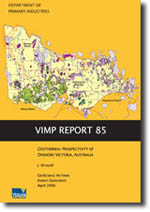VIMP Report 85 - Geothermal Prospectivity of Onshore Victoria, Australia
 |
| |||||
Product description:Executive SummaryIn 2005, the State of Victoria passed the Geothermal Energy Resources Act (GER Act), which provides a new framework for the large-scale commercial exploration and extraction of geothermal energy in the State at depths greater than 1 000 m, and at temperatures greater than 70 °C. Small-scale projects, such as balneology, ground heat pumps and aquaculture, are excluded, and these will continue to be regulated by existing planning, environmental and water legislation. Initially, acreage across the whole State will be gazetted on April 11th 2006, with the bidding process spanning six months. A total of 31 geothermal exploration areas (GEPs) cover the State, with the maximum area being approximately 10 000 km2. If there are no successful bidders for a gazetted area, then acreage can be applied for on a ‘first-come, first-served’ basis. Previous studies have attempted to map the geothermal prospectivity in Victoria, though the reliability of the data collected, and the sources of the data used in these studies, have often been unclear. Consequently, GeoScience Victoria has attempted to identify and collate all open-file geothermal data collected to date in Victoria. In addition, all published data have been traced to their original sources, where possible, and quality assessed. An initial appraisal of potential heat sources in Victoria, such as the spatial distribution of magmatic intrusions and radiogenic plutons, and the areal extent of the Older and Newer Volcanic provinces, has been undertaken. By incorporating these data, it has been possible to construct a generalised ‘geothermal play fairway’ map of Victoria and thus delineate the more prospective areas for exploration. The vast majority of wells and boreholes utilised in this report are clustered within the Gippsland and Otway basins. This is a function of both the existence of deep, permeable sedimentary sequences in these basins that are suitable for groundwater purposes and the relative focussing of the petroleum industry’s exploration work in these areas. It is important to recognise that the lack of relevant data in other areas of Victoria does not necessarily relate to a lack of geothermal potential. The coal blanketing effect in the Gippsland Basin leads to elevated geothermal gradients and results in anomalous extrapolated temperatures at depth. In addition, the shallower wells are affected by both diurnal and seasonal effects and by abnormal climatic trends. Consequently, all wells and boreholes less than 300 m deep have been excluded from our temperature database and those less than 1000 m deep are excluded from the geothermal temperature-at-depth mapping. A temperature map showing the ‘depth to 150 °C’ is presented for the Gippsland and Otway basins. The Murray Basin and Tasman fold belt areas are excluded as the insufficient number of available datasets would lead to erroneous contouring. GeoScience Victoria’s preliminary investigation suggests that Victoria does have sufficient temperatures to produce electricity commercially from binary power plants. The Ormesa binary geothermal complex in California reported an availability factor of 97.6% using geofluid temperatures of 137 °C (Sonnelitter et al., 2000). Several electrical power plants are utilising water at even cooler temperatures; these include the Wabuska geothermal plant in Nevada (104 °C), the Nagqu geothermal plant in China (110 °C) and the Fang geothermal plant in Thailand (116 °C). Bibliographic reference Driscoll, J., 2006. Geothermal Prospectivity of Onshore Victoria, Australia. Victorian Initiative for Minerals and Petroleum Report 85, Department of Primary Industries. | ||||||

